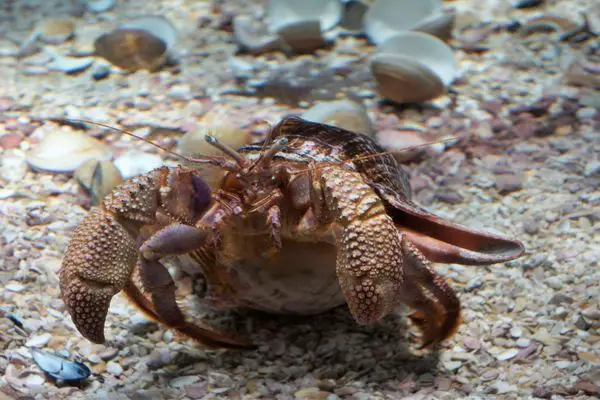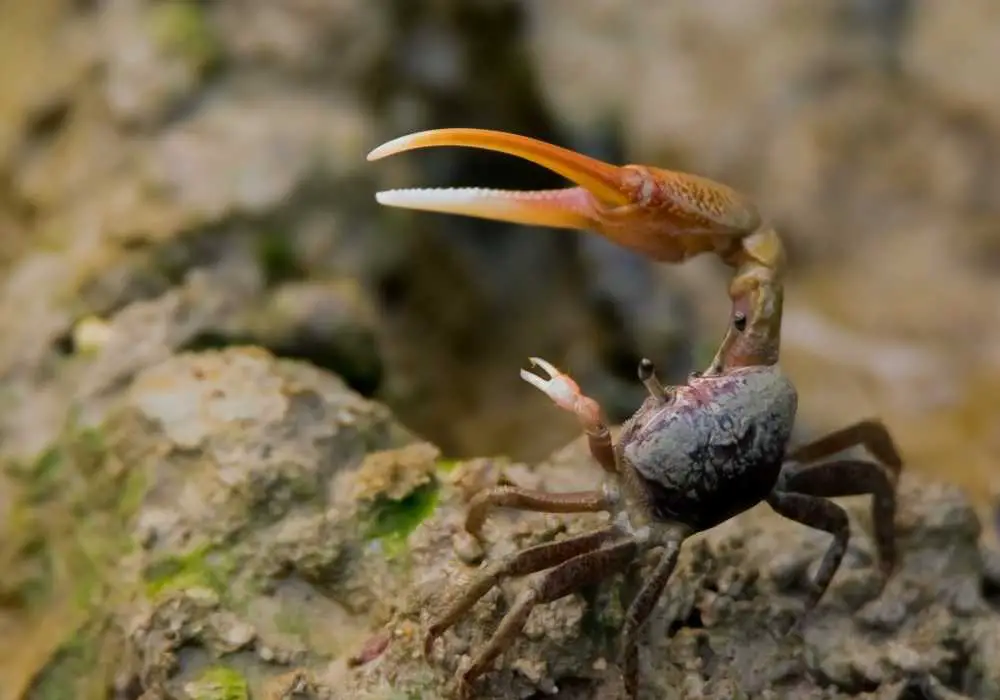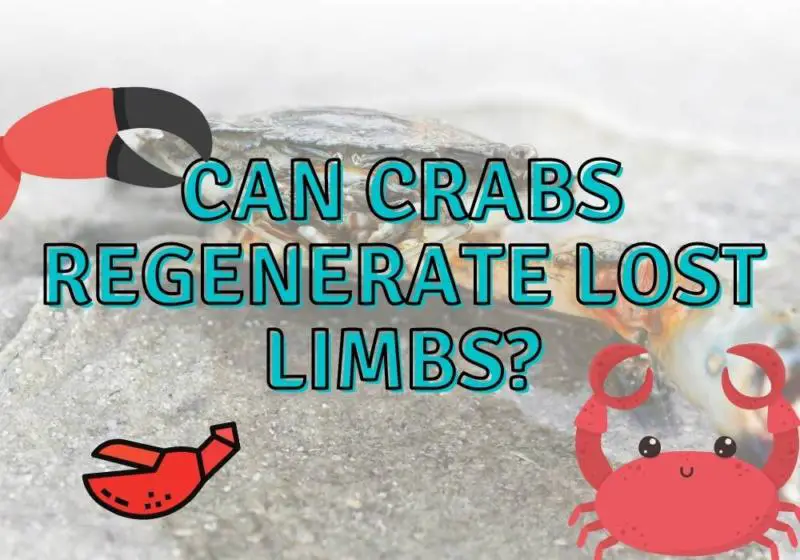A crab’s anatomy is very different from a human’s. A crab has a segmented body with an exoskeleton, which is a hard outer shell that protects the animal’s body and organs.
Crabs have a pair of eyes, two antennae used to sense their surroundings, and five pairs of walking legs. The front set of walking legs is the claws, which are one of their most interesting features.
Just like other crustaceans e.g. Crayfish and lobsters, crabs can indeed regrow their limbs. Crabs have evolved this ability due to their limbs being relatively loosely attached and are prone to loss when fighting other crabs for territory, mates and food.
The regrowth process happens in conjunction with their molting (replacement of their exoskeleton) which happens once a year for larger species.
While crabs can regrow all their legs and claws (which are technically also legs) they cannot regrow more advanced organs such as their eyes.
Except for lizards regrowing their tails, crabs are perhaps the animals best known for their ability to regenerate lost limbs. It’s one of the reasons why they are often used in science experiments.
It is not always a certain process though, as the success of regeneration depends on many factors. Scientists are still not sure how this process works, but they have concluded that it is an energy-dependent process.
If crabs do not have enough food, then they cannot regenerate lost parts of their body. The same can be said about when there is a lack of oxygen in water or when there is too much light.
Contents
Why Do Crabs Lose Their Claws?
The reason why a crab could lose its claws will vary depending on the environment, whether it is in captivity, a fishery, or wild.
Most crabs lose their legs or claws in fights with predators such as octopuses, sea birds or other crabs.
Because crabs do not shy away from eating each other, and they often inhabit the same environments, fighting for territories, mating opportunities and food are likely to be the most common cause of crabs losing their libs.
A crab may lose also lose a claw for a variety of other causes, such as living in a too dry environment. Poisoning, such as paint fumes or chemicals, can cause a crab to lose a claw.

Changes in environmental conditions, such as being hot or cold, humid or dry, stress crabs. So when crabs lose limbs, it might be an indication of stress or illness. It is critical to keep your tank/environment as near to the natural habitat as possible.
If you have over one crab in the same environment, one of them may have torn off the claw of the other during a struggle. How common this depends on the variety of crab (e.g. Emerald Crabs, fiddler crab, and so on)
Declawing Crabs for Food
Crabs are popular seafood items, but there is a very controversial way of obtaining their claws for food. Crab fishers will often use the claw-removal technique known as “decapitation” or “de-clawing” in order to obtain the delicious claw meat without actually killing the crab itself.
The “declawing” of crabs for food is a controversial process that has been illegal in the European Union (EU) since 2013. The EU’s ban came after research showed that the process causes “considerable pain and distress.” Despite this, some countries outside the EU still allow the practice.

In some states such as Louisiana and Florida, it is illegal to catch some crabs such as the popular Stone Crab whole, but it is still legal to remove its claws for food.
The thought behind allowing declawing but not fishing for the entire crab is that it can be viewed as a more sustainable form of fishing as they will eventually grow the claws back. Although, declawing may cause distress and lower the survival rate of the crabs.
Crabs Can Detach Their Claws on Purpose!
Crabs are well-known for sacrificing a claw if they are attacked by a predator. But because they later regenerate the claw, this often does not seem like a big deal to them.
Indeed, they are prepared to lose many limbs if required in order to evade a predator or other dangers.
Can Crabs Regrow Claws?
Stone crabs lose claws in two ways: they can be forcibly broken off by fishers or lost in a fight. They may also drop any of their legs or claws if they are wounded or unwell.
A stone crab’s claws can only be regrown if the joint that connects the claw to the body is left intact.
When a stone crab loses a claw or another appendage, it takes several moults for the appendage or claw to entirely regrow. When a crab moults, it possesses the potential to restore the appendage that was lost.
A claw may restore 95 per cent of its former size after three moults (three years in adult crabs). The regrowth of missing appendages in young stone crabs can be faster than in adults. Juvenile crabs moult two or more times each year, allowing them to rebuild an appendage in a matter of months.
Can a Crab Survive Without Claws?
According to the published declawing research, 47 % of crabs declawed by double amputation perished from the trauma, whereas 28 per cent of crabs declawed by single amputation died.
Crabs without claws ate just fish, neither oysters nor mussels. Crabs that still had a pincer claw used other legs to support mussels or oysters before crushing them with the pincer claw. Clawless crabs in the wild may become hungry if they don’t discover available food that doesn’t need to be crushed.
If the diaphragm at the body/claw joint is intact, crabs have a far greater chance of surviving. The diaphragm acts as a seal, closing the incision and stopping the bleeding. In the wild, survival rates can approach 100%.
Because of their advanced age, large crabs of all sexes are unlikely to regrow claws, before they die from natural reasons.
Of course, not all crabs have the same leg and claw configuration. Most crabs have ten appendages but the King Crab has six walking legs, a feeder claw, and a killer claw. Different varieties of crab also have a variety of diets. Ghost Crabs for example are scavengers and rely less on their claws.
Can a Hermit Crab Live Without Its Big Claw?
Your hermit crab may lose a claw for a variety of causes, such as fights, getting stuck, being stressed or living in a too dry environment. Light poisoning, such as paint fumes or chemicals, can cause a crab to losing a claw.
If you have more than one crab in the same environment, one of them may have torn off the claw of the other during a struggle. A single crab might lose a claw if it becomes entangled in wires or a net etc.
Don’t be disheartened if your hermit crab loses a claw. In the habitat’s corner, place a dish with a damp sponge to create humidity and keep your hermit crab healthy.

Every day, mist him with water. Keep him away from strong odours; if you’re having pesticides applied to your home, move the habitat outside.
There is no cure for a crab without a claw. You don’t need to intervene since its body will repair the harm on its own.
Hermit crabs must lose their thick exoskeletons and allow their exposed flesh to solidify. This is when they change shells.
Another remarkable feature of the moulting process is that it allows the crab to regenerate a lost claw.
As your crab’s claw regrows, you may see a gooey-looking glob, white or light grey, at the end of the leg bud where the claw used to be. This is known as a limb bud, and it represents the beginning of your crab’s new claw.
How Long Does It Take For a Crab Claw To Grow Back?
Adult crab regeneration takes a year or so owing to the seasonal moulting of adult females in the fall and adult males in the winter.
The exact time it takes depends on the frequency of moulting and younger crabs will moult more often than older and larger ones. Whereas young crabs moult several times a year, older ones moult rarely or not at all.
The regenerated claws begin smaller than the originals and continue to expand when the animal moults.

It emerges right before your crab’s moult. Much of the new claw should be present and functioning after moulting, however, it may take two to three moulting cycles for a claw to recover.
Interestingly, some crustaceans like lobsters are able to moult, in theory, an unlimited number of times! They are practically immortal, but there will be longer between moults the older they get.
Can Crabs Regrow All Of Their Legs?
When a crab moults, it has the potential to regrow a lost limb. The regenerated claws begin smaller than the originals and continue to expand when the animal moults.
A claw may restore 95 per cent of its former size after three moults (three years in adult crabs).
Hermit crabs lose their legs occasionally, but they grow back during future moults- shedding their exoskeleton as it grows larger.
Leg loss may result from stress induced by a variety of circumstances, such as tank conditions, fighting, and mites.
Crab legs renew in the same way that claws do, as limb buds right before a moulting cycle. Even if your crab is missing a claw and a few legs, they will most likely grow back the next time he moults.
Is it Painful When a Crab Has a Claw or Leg Removed?
Crabs have highly developed senses of sight, smell, and taste, and evidence suggests that they may detect pain. They have two primary nerve centres, one in the front and one in the back.
They experience and react to pain, as do other creatures with nerves and a variety of other senses.
However, the psychological experience of pain for a crab, lobster or crayfish that looses its limb is very likely to be much different from that of human experiencing pain.
Humans experience intense emotional disruptions upon trauma that are undertaken by parts of the brain not present in crustaceans.
Concluding remarks
Crabs are fascinating creatures that, along with their crustacean causing such as crayfish and lobsters, are able to regrow most of their limbs if lost.
If you are interested, I also wrote an article about this phenomenon in crayfish but also in lobsters that you can read here.




